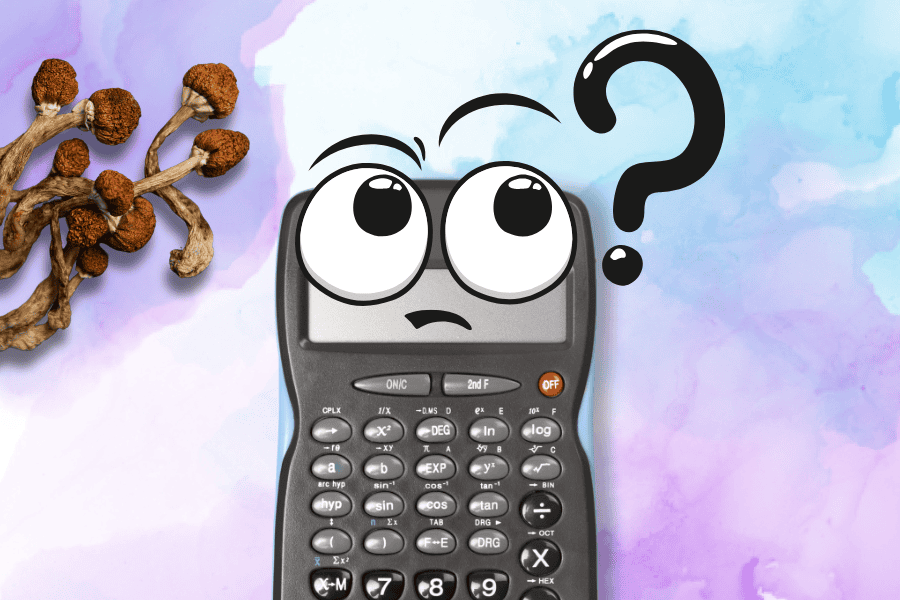Magic mushrooms have been commercially available since the 1950s. With their ups and downs, they’re frequently the focus of numerous studies, some of which explore how they’re absorbed by the body. That’s exactly what we’re going to explore today, so buckle up, and let’s get started!
Psilocybin Metabolism
In order to figure out how shroom edibles are absorbed by the body, we have to check the substances that are active in the edibles. If you are interested in shroom edibles, you must have heard about magic mushrooms and their main active components psilocybin and psilocin. Let us go into the detail of how psilocybin, together with its derivative, psilocin, is absorbed by the body and in turn leads to the typical psychedelic effects.
Let’s take a better look at the process by which psilocybin (as well as its derivative, psilocin) traverses the human body and induces the well-known psychedelic effects. We seek to clarify the physiological processes involved, investigating individual differences and variables on how psilocybin is absorbed.
The shroom edibles start decomposing in your stomach as soon as you consume them. Psilocybin, the products active ingredient, enters the circulation after being absorbed in the stomach and intestines. It’s important to fully chew the edible before ingesting it to hasten this breakdown process and improve absorption. Psilocybin is carried to the liver by the hepatic portal vein after being absorbed by the circulation, where it undergoes important metabolic activities.
However, before proceeding further, we need to understand an important aspect of shroom edibles, their substantial psilocin content. Psilocin serves as the primary active ingredient and is the form into which psilocybin transforms within the body. When consumed in their natural state, magic mushrooms contain a quantity of psilocin approximately equivalent to psilocybin.
Psilocin Metabolism
Dephosphorylation is the mechanism by which psilocybin is transformed into psilocin. It involves removing a phosphate group from an organic compound like psilocybin through hydrolysis. Picture the phosphate group as a cluster of molecules being separated from the rest. Hydrolysis occurs when a water molecule breaks the chemical bond, effectively splitting the phosphate group.
The enzymes responsible for this process are alkaline phosphatases. Enzymes are biological catalysts, typically proteins, that speed up or enable chemical reactions. Simply put, your body uses familiar mechanisms to convert psilocybin into psilocin, a process predominantly carried out in the liver.
How Does It Affect the Brain
About half an hour after consumption, the psychoactive substance psilocin mimics the effects of serotonin, a neurotransmitter in the serotoninergic system. The monoamine neurotransmitter serotonin is involved in many different aspects of brain function, including mood regulation, learning, and memory.
Psilocin mostly binds to serotonin receptors, namely 5-HT2B, 5-HT2C, and 5-HT1A, which are mainly found in the cerebral cortex, which makes up approximately 40% of the total mass of the brain. The effects of psilocybin primarily target these receptors.

Psilocybin is not limited to a single-receptor binding site, but rather, fMRI studies show that the effects of psilocybin go beyond the simple receptor binding. These studies reveal decreased blood flow and connectivity between regions like the medial prefrontal cortex (mPFC) and the posterior cingulate cortex (PCC), as well as other central ‘hub’ regions such as the thalamus and anterior cingulate cortex. These findings suggest that psilocybin-induced alterations in brain activity are characterized by the ability to think freely in new and creative ways without feeling limited.
Besides this, psychedelics induce an ‘entropic‘ brain state characterized by a larger extent of disorder or disintegration per fMRI scan. The areas of the brain that are normally active during this task show reduced activation, while the entire brain is more connected overall.
What Influences Psilocybin Retention
Psilocin which resulted from the metabolic transformation of psilocybin, the well-known psychedelic substance of magic mushrooms, is responsible for both psychedelic effects and retention in the body. The duration of these effects varies, influenced by several factors influencing the compound’s retention in the body.
The method of ingestion plays a pivotal role in psilocybin retention. Psilocybin molecules, which are absorbed orally, undergo the first-pass effect within the liver and are converted to psilocin over the course of about an hour. As a consequence, the effects last for about six hours. After the “trip” has ended, psilocybin is slowly removed from the body. On the contrary, intravenous administration causes rapid metabolism and elimination of the drug with effects that last only a couple of hours. Keep in mind that intravenous administration was done in clinical settings with pure extracted psilocybin, doing something like that at home is extremely dangerous and may end up in a fatal outcome.
Similarly, dosage influences psilocybin retention, because the more substance you ingest, the longer its metabolism process will be, resulting in the longer presence of the compound in your body. The metabolic process of higher doses is slower and psilocybin is retained in the body for longer periods, compared to the lower ones, for example, microdosing.
Detection of Shroom Edibles in the Body
Multiple ways can be used to detect psilocybin in the body, with urine testing being the most common. When urine samples are tested, psilocybin can be detected 24 hours after taking shroom edibles. Yet, other compounds found in shrooms may remain in the body longer, complicating detection.

The lab analysis of hair roots is an alternative approach that is capable of detecting psilocybin use for up to 90 days. Nevertheless, hair screenings are taken less often but are able to reflect back much longer compared to urine tests. It is extremely important to realize that psilocybin is not included in the standard drug screenings, thus a person can only get tested for psilocybin if there’s a suspicion of using this particular substance. However, there’s a possibility of psilocybin yielding a false positive for other substances.
For those who are concerned about drug tests, there are a couple of ways how to prepare and remove psilocybin from your system. Stay hydrated before, during, and after taking shroom edibles. Water flushes out the system and lowers the level of psilocybin. Moreover, just as with any other substance it is recommended to avoid psilocybin use for at least 24 hours before taking the test.
Final Word
While eating shroom edibles is easy, understanding how they work can sometimes be confusing. Hopefully, we cleared the confusion and now you can know exactly what’s happening in your body when you consume them. While shroom edibles are a tasty way to enjoy the psychedelic effects of magic mushrooms without the nasty taste, make sure not to get carried on and end up eating way too much. Stay safe and happy tripping!




